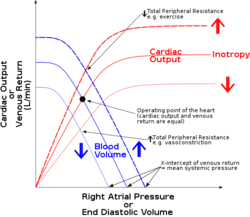Copy link
CHF Frank Starl curve: Phenylephrine
Last updated: 03/04/2015
The Frank-Starling Curve
The most common type of heart failure is systolic dysfunction. With systolic dysfunction, the Frank-Starling curves shifts down and to the right because of the loss of contractility. Stroke volume can be increased by increasing inotropy, decreasing the afterload, or increasing the preload. Increasing preload will not necessarily increase stroke volume in heart failure patients, and may make pulmonary or systemic congestion worse.
Decreasing afterload with vasodilators can improve stroke volume and ejection fraction because the afterload is often elevated in heart failure and these drugs can increase stroke volume and decrease preload.
Inotropic drugs can increase stroke volume and ejection fraction, and are often used in the treatment of heart failure. Inotropes, like sympathomimetics and phosphodiesterase inhibitors, can increase stroke volume, increase ejection fraction, and reduce preload in the short term. However, prolonged use of inotropic drugs have been shown to increase mortality in some patients, specifically because they can increase oxygen demand.
Phenylepherine is a direct acting sympathomimetic drug that increases venous constriction more than it increases arterial constriction, by acting as an alpha-1 agonist. Acutely, administration of PHE may lead to increase in preload, with increased venous return to the heart, which may (as discussed above) help increase stroke volume somewhat. Importantly, however, this effect is only transient, and over the long run the increase in venous resistance will decrease venous return (and thus preload). Importantly, phenylephrine also leads to an increase in afterload, with increased systemic vasoconstriction. Because alpha1-agonists produce systemic vasoconstriction, the work of the heart increases. If the coronary circulation is impaired the decrease in myocardial oxygen supply/demand ratio can precipitate angina, and has been shown to increase mortality in heart failure patients.
Whether or not PHE has intrinsic effects on myocardial contractility has in the past been controversial, however the most recent human data (based on infusion directly into the coronary arteries) suggest that PHE does exert mild effects on the myocardium (increased contractility), but that this effect is attenuated in patients with heart failure. Note that phenylephrine has never been shown to increase cardiac output in any human population.

References
- S Magder, S Veerassamy, J H T Bates. A further analysis of why pulmonary venous pressure rises after the onset of LV dysfunction. J. Appl. Physiol.: 2009, 106(1);81-90 PubMed Link
- Robert H Thiele, Edward C Nemergut, Carl Lynch. The clinical implications of isolated alpha(1) adrenergic stimulation. Anesth. Analg.: 2011, 113(2);297-304 PubMed Link
- J S Landzberg, J D Parker, D F Gauthier, W S Colucci. Effects of myocardial alpha 1-adrenergic receptor stimulation and blockade on contractility in humans. Circulation: 1991, 84(4);1608-14 PubMed Link
Copyright Information

This work is licensed under a Creative Commons Attribution-NonCommercial-NoDerivatives 4.0 International License.